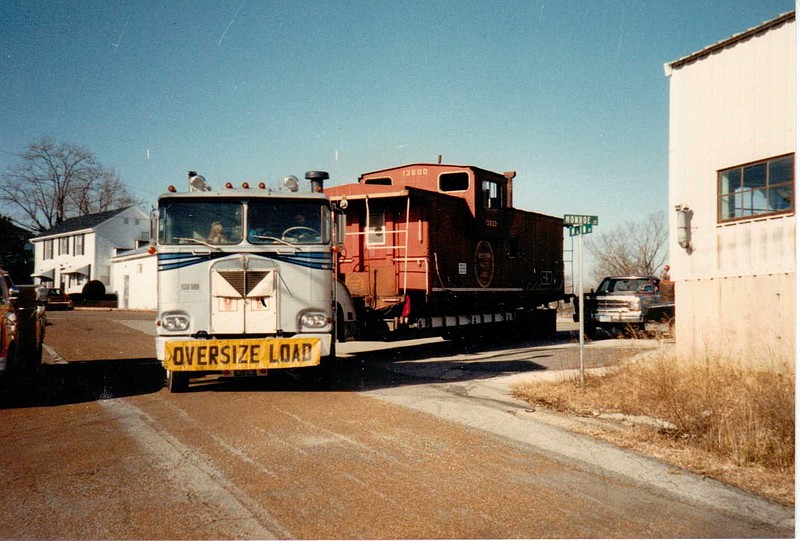Railroad Park in downtown Russellville serves as a open-air museum of sorts, preserving the community’s rich legacy as a stop along the former Bagnell Branch of the Missouri Pacific Railroad.
The focal point of this recreational area is a caboose resting upon property where the railroad ran several decades ago, representing hours of hard work and labor by many local residents who wanted a tangible symbol of bygone railroad history.
“The Sesquicentennial Celebration held June 10, 11, & 12, 1988, was a great success and, in September, the committee met to discuss the profits from the celebration,” wrote the late Don and Berniece Jungmeyer. “There was much discussion as to what could be purchased to commemorate the celebration. Several suggestions were made, one being a caboose.”
Jack Casten, a local resident who served two terms as Russellville’s mayor, was a conductor for Union Pacific Railroad. He inquired through official company channels about the steps to be taken to acquire a caboose for his community.
“Not long after he made the inquiry, my husband was informed that the railroad had a surplus caboose,” Rita Casten said. “A few weeks later, the committee learned the caboose was on its way to the old railroad stop in Centertown and that it could be picked up there.”
On Saturday, Oct. 15, 1988, a crew of eager local volunteers led by Casten traveled to Sandy Hook to pick up railroad ties and rails to be used to prepare the site where the caboose would soon be displayed. The use of a boom truck and trailer were donated to transport, load and unload the material.
Three days later, with a caboose ready for pickup in Centertown, the sesquicentennial committee met again to determine the most suitable location for placement of the railroad car. Although several sites were discussed, the final decision was for it to be placed on school property adjacent to a ball field and a tennis/basketball court.
Preparations continued as volunteers toiled to ensure the site was ready by digging holes, pouring the pads and setting the rails. Jack Casten and Don Jungmeyer traveled to Centertown to remove items aboard the caboose to prepare it for transport along the highway.
“Anyone traveling from Centertown to Russellville saw a strange sight (on Dec. 17, 1988) as two men with a 2x4 (board) were going down the road, stopping here and there to measure,” wrote Don and Berniece Jungmeyer. “Yes, Don and Jack were measuring to see how many wires would have to be raised for the caboose to pass under.”
Rita Casten recalled, “The caboose was loaded on the back of a tractor trailer and brought down State Highway U to Russellville (on Dec. 20, 1988). “The utility companies came out to elevate the electric lines along the way so that it could pass through without damaging the lines.”
When the caboose arrived in Russellville following its 45-minute trip along the rural two-lane highway, it was placed on the prepared site and then welded to the track. The following spring, volunteers attached steps to the caboose.
For the next quarter-century, the caboose became a point of interest for the community and essentially a playground for local kids who enjoyed exploring its sparse interior. But since it was not located in an area consistently under the eye of watchful adults, windows were damaged, walls spray-painted and it fell into a state of disrepair.
The caboose was located a short distance south of the original Bagnell Branch, having little connection to the town’s railroad history.
In 2013, during preparations for celebration of a major milestone in Russellville’s history, a new group of volunteers came together to give the caboose a facelift and relocate to a site where it would have historical context.
“Early Wednesday morning, the combined efforts of crews from Twehous Excavation, Scott’s Crane Service and Larry Payne Excavation moved the caboose from Russellville City Park to its new home in the newly completed Railroad Park in its downtown …,” reported the Russellville Rebel newsletter on May 9, 2013.
It further explained, “The park is being created with donations, volunteers and grants. The hope is to have the first phase of the park complete by the June Engine Show and Frog Leg Festival to celebrate Russellville’s 175th anniversary.”
Situated a short distance east of the former railroad depot and near the original railroad tracks, the caboose has since been sandblasted and repainted. Railroad Park now has not only the caboose, but military memorials in addition to picnic tables, benches and a restored railroad icehouse.
Reflecting on her late husband’s 29 years of service with Union Pacific Railroad and involvement with helping coordinate the acquisition of the caboose, Rita Casten maintains it was a bittersweet moment seeing the railcar moved to Railroad Park several years ago.
“Jack adored trains and was so proud of all the volunteers that helped bring the caboose to town in 1988,” she said. “When they moved it to Railroad Park in 2013, I initially had my reservations, but I realized it would bring more people to the downtown and help preserve the railroad legacy.”
She added, “Seeing the caboose now connects me to memories of him and his love of the railroad, and I know if he were here, he would have supported it because it helps improve the town.”
Jeremy P. Ämick writes on behalf of the Silver Star Families of America.

